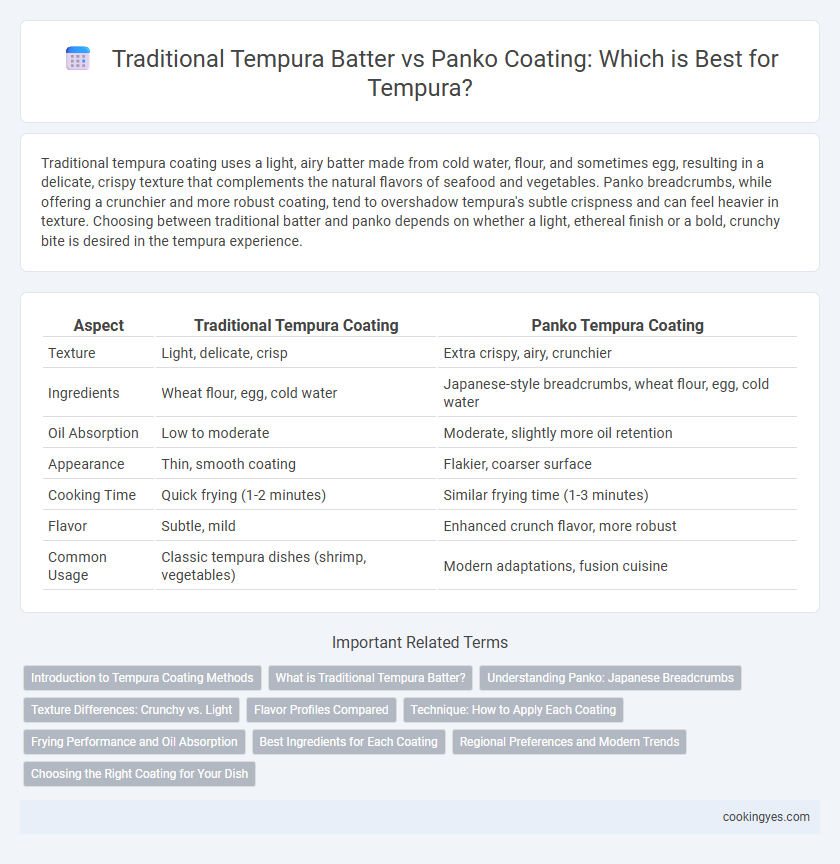Traditional tempura coating uses a light, airy batter made from cold water, flour, and sometimes egg, resulting in a delicate, crispy texture that complements the natural flavors of seafood and vegetables. Panko breadcrumbs, while offering a crunchier and more robust coating, tend to overshadow tempura's subtle crispness and can feel heavier in texture. Choosing between traditional batter and panko depends on whether a light, ethereal finish or a bold, crunchy bite is desired in the tempura experience.
Table of Comparison
| Aspect | Traditional Tempura Coating | Panko Tempura Coating |
|---|---|---|
| Texture | Light, delicate, crisp | Extra crispy, airy, crunchier |
| Ingredients | Wheat flour, egg, cold water | Japanese-style breadcrumbs, wheat flour, egg, cold water |
| Oil Absorption | Low to moderate | Moderate, slightly more oil retention |
| Appearance | Thin, smooth coating | Flakier, coarser surface |
| Cooking Time | Quick frying (1-2 minutes) | Similar frying time (1-3 minutes) |
| Flavor | Subtle, mild | Enhanced crunch flavor, more robust |
| Common Usage | Classic tempura dishes (shrimp, vegetables) | Modern adaptations, fusion cuisine |
Introduction to Tempura Coating Methods
Tempura coating methods primarily include traditional batter and panko breadcrumbs, each offering distinct textures and culinary experiences. Traditional tempura batter, made from cold water, flour, and egg, creates a light, delicate, and crispy coating essential to Japanese tempura dishes. Panko, Japanese breadcrumbs, provide a crunchier, more substantial texture, often used in dishes like Katsu but less common in classic tempura preparations.
What is Traditional Tempura Batter?
Traditional tempura batter is made from a simple mixture of cold water, wheat flour, and sometimes egg, which creates a light and delicate coating that crisps quickly without absorbing excess oil. This batter's low gluten content and minimal ingredients result in a thin, airy texture that enhances the natural flavors of seafood or vegetables. Unlike panko breadcrumbs, traditional tempura batter produces a smooth, almost translucent crust that remains tender and less crunchy.
Understanding Panko: Japanese Breadcrumbs
Panko, Japanese breadcrumbs, offer a distinctive texture for tempura with their light, airy, and coarser crumb structure compared to traditional tempura batter's thin, crispy coat. Unlike the smooth, delicate finish of the classic tempura batter made from flour, egg, and cold water, panko creates a crunchier, more robust coating that retains less oil for a less greasy taste. Using panko enhances tempura with an added crunch and a golden appearance, appealing to those seeking a heartier, more substantial crust while maintaining the essence of Japanese culinary tradition.
Texture Differences: Crunchy vs. Light
Traditional tempura batter creates a light, delicate texture with a subtle crispness that allows the natural flavors of seafood and vegetables to shine through. Panko coating delivers a distinctly crunchy and coarse surface, adding a robust crispness that enhances the overall bite. The choice between traditional tempura batter and panko significantly impacts the texture profile, balancing between airy lightness and pronounced crunchiness.
Flavor Profiles Compared
Traditional tempura batter offers a light, airy texture with a subtle, delicate flavor that allows the natural taste of seafood or vegetables to shine through. Panko coating provides a crunchier, heartier bite with a slightly toasted, savory flavor that adds depth and contrast to the dish. Choosing between the two greatly influences the overall sensory experience, balancing between crispness and flavor intensity.
Technique: How to Apply Each Coating
Traditional tempura batter is made with ice-cold water, wheat flour, and sometimes egg, applied by dipping ingredients quickly to achieve a light, delicate coating that crisps without absorbing excess oil. Panko breadcrumbs require a different technique: ingredients are first lightly dusted with flour, dipped in beaten egg, and then gently pressed into panko to create a thicker, crunchier crust. Mastering the temperature of the batter for traditional tempura and the egg wash consistency for panko crucially affects the final texture and adherence of each coating.
Frying Performance and Oil Absorption
Traditional tempura batter, made from cold water and soft wheat flour, creates a light, crispy texture with minimal oil absorption due to its thin coating and quick frying. Panko breadcrumbs, commonly used in Japanese frying, form a thicker crust that absorbs more oil, resulting in a crunchier but heavier coating. Frying performance with traditional batter achieves a delicate, airy finish ideal for tempura, while panko provides a robust texture better suited for fried foods requiring longer cooking times.
Best Ingredients for Each Coating
Traditional tempura coating relies on a delicate batter made from ice-cold water, low-gluten wheat flour, and sometimes egg yolk to ensure a light, crispy texture that enhances the natural flavors of seafood and vegetables. Panko, a Japanese-style breadcrumb made from bread without crusts, offers a coarser, crispier batter ideal for frying thicker items like chicken or shrimp, providing a crunchier bite. The best ingredients for traditional tempura include high-quality, unbleached wheat flour and chilled water to prevent gluten development, while premium panko breadcrumbs made from fresh bread maintain optimal texture and golden color.
Regional Preferences and Modern Trends
Traditional tempura coating, characterized by a light, airy batter made from cold water, flour, and sometimes egg, remains popular in Japan for its delicate crunch and subtle flavor. In contrast, panko, a Japanese-style breadcrumb, is increasingly favored in Western and fusion cuisines for its thicker, crispier texture and ability to hold up well with heavier sauces. Modern trends blend both methods, with chefs experimenting regionally to balance authenticity and bold textures, catering to evolving palates and diverse culinary experiences.
Choosing the Right Coating for Your Dish
Traditional tempura batter, made from cold water, flour, and egg, provides a light, crispy texture that allows the natural flavors of seafood and vegetables to shine. Panko breadcrumbs create a thicker, crunchier coating ideal for heartier ingredients like chicken or pork, offering a satisfying contrast in texture. Selecting the right coating depends on the desired crispiness and the ingredient's delicate or robust nature, ensuring optimal flavor and mouthfeel in your tempura dish.
Traditional vs Panko for Tempura Coating Infographic

 cookingyes.com
cookingyes.com